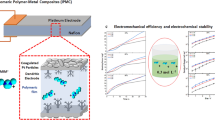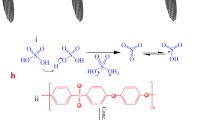Abstract
Nafion/Pt-based ionic polymer metal composites can be considered smart materials with characteristics that allow it to be used as soft actuators. Its working mechanism is based on solvated counterions moving through hydrophilic sites of the polymer membrane, making it an electrochemical device. Since a minimum of 2 V is needed to actuate, water electrolysis is a drawback that must be overcome, once its occurrence inhibits the properly working of ionomeric polymer/metal composite (IPMC). With individually four distinct counterions incorporated H+, Li+, Na+ and BMIM+— an organic cation from ionic liquid 1-butyl-3-methyl-imidazolium chloride — Nafion/Pt-based IPMCs had their electrochemical properties investigated through cyclic voltammetry, multi-step chronoamperometry and electrical impedance, as well as mass change during exhaustive actuation cycles and their chemical affinity with hydrophilic sites were analysed by quantum mechanics simulation. From the collected data, it was possible to infer that the physical-chemical aspects of counterions play a key role in device-measured property, and BMIM+ prevented early water electrolysis, providing electrochemical stability to the device. Real-time mass-monitored actuation shows that water loss occurs excessively on smaller radius counterions and although the fast reabsorption kinetics, molecular diffusion to the innermost regions of the membrane is slow and does not lead to a recovery of device’s performance. Electrochemical impedance spectroscopy data corroborate the fact that mass transport is strongly affected by both the limited ionomeric channel width and the interaction between the species and the Nafion side chains.








Similar content being viewed by others
References
Bonomo C., Fortuna L., Giannone P., Graziani S., Strazzeri S. (2006) Motion Sensors and Actuators Based on Ionic Polymer-Metal Composites. In: Baglio S., Bulsara A. (eds) Device Applications of Nonlinear Dynamics. Understanding Complex Systems. Springer, Berlin, Heidelberg, pp 83–99
Tiwari R, Kim KJ (2013) IPMC as a mechanoelectric energy harvester: tailored properties. Smart Mater Struct 22:015017
Obeidat AM, Gharaibeh MA, Obaidat M (2017) Solid-state supercapacitors with ionic liquid gel polymer electrolyte and polypyrrole electrodes for electrical energy storage. J Energy Storage 13:123–128
Naji L, Safari M, Moaven S (2016) Fabrication of SGO/Nafion-based IPMC soft actuators with sea anemone-like Pt electrodes and enhanced actuation performance. Carbon N Y 100:243–257
Bar-Cohen Y, Cardoso VF, Ribeiro C, Lanceros-Méndez S (2017) Electroactive polymers as actuators. In: Uchino K (ed) Advanced piezoelectric materials. Elsevier, pp 319–352
Shahinpoor M (2000) Ion-exchange polymer-metal composites as biomimetic sensors and actuators. In: Polymer sensors and actuators. Springer, Berlin, pp 325–359
Karimi MB, Mohammadi F, Hooshyari K (2019) Recent approaches to improve Nafion performance for fuel cell applications: A review. Int J Hydrogen Energy 44:28919–28938. https://doi.org/10.1016/j.ijhydene.2019.09.096
Cha Y, Porfiri M (2014) Mechanics and electrochemistry of ionic polymer metal composites. J Mech Phys Solids 71:156–178
Min Jung Kim, Sang Woo Park, Joohye Won, and Changwoon Nah "Effects of ionic liquids on the performance of IPMC", Proc. SPIE 10163, Electroactive Polymer Actuators and Devices (EAPAD) 2017, 1016335 (17 April 2017). https://doi.org/10.1117/12.2261650
Oguro K, Takenaka H, Kawami Y (1993) Actuator element. US Pat 5,268,082
Hamburg E, Zondaka Z, Punning A, Johanson U, Aabloo A (2016) Some electrochemical aspects of aqueous ionic polymer-composite actuators. In: Bar-Cohen Y, Vidal F (eds) Electroactive Polymer Actuators and Devices (EAPAD) 2016. p 979815
Yılmaz OC, Sen I, Gurses BO, Ozdemir O, Cetin L, Sarıkanat M, Seki Y, Sever K, Altinkaya E (2019) The effect of gold electrode thicknesses on electromechanical performance of Nafion-based ionic polymer metal composite actuators. Compos Part B Eng 165:747–753
O’Keeke TJ (2001) Pourbaix diagrams. In: Encyclopedia of materials: science and technology. Elsevier, pp 7774–7781
Nemat-Nasser S, Wu Y (2003) Comparative experimental study of ionic polymer-metal composites with different backbone ionomers and in various cation forms. J Appl Phys 93:5255–5267
Oguro K, Asaka K, Fujiwara N, Onishi K, Sewa S (1999) Polymer electrolyte actuator driven by low voltage. MRS Proc 600:229
Oguro K (2014) Preparation procedure ion-exchange polymer metal composites (IPMC) mebranes,. 4–6. http://ndeaa.jpl.nasa.gov/nasande/lommas/eap/IPMC_PrepProcedure.htm
da Trindade LG, Zanchet L, Padilha JC, Celso F, Mikhailenko SD, Becker MR, de Souza MO, de Souza RF (2014) Influence of ionic liquids on the properties of sulfonated polymer membranes. Mater Chem Phys 148:648–654
Wee LK, Lee TL (2012) Video Analysis and Modeling Tool for Physics Education: A workshop for Redesigning Pedagogy. 4th Redesigning Pedagog Conf 2:4–8. arXiv:1207.0220
Stewart JJP (1990) MOPAC: a semiempirical molecular orbital program. J Comput Aided Mol Des 4:1–103
Stewart JJP (2017) An investigation into the applicability of the semiempirical method PM7 for modeling the catalytic mechanism in the enzyme chymotrypsin. J Mol Model 23:154
Schaftenaar G, Noordik JH (2000) Molden: a pre- and post-processing program for molecular and electronic structures. J Comput Aided Mol Des 14(2):123–134
Schaftenaar G, Vlieg E, Vriend G (2017) Molden 2.0: quantum chemistry meets proteins. J Comput Aided Mol Des 31(9):789–800
Sinnecker S, Rajendran A, Klamt A, Diedenhofen M, Neese F (2006) Calculation of solvent shifts on electronic g-tensors with the conductor-like screening model (COSMO) and its self-consistent generalization to real solvents (direct COSMO-RS). J Phys Chem A 110(6):2235–2245
Lee JW, Yoo YT (2011) Preparation and performance of IPMC actuators with electrospun Nafion ®-MWNT composite electrodes. Sensors Actuators B Chem 159:103–111
Bendert JC, Papadias DD, Myers DJ (2010) The effect of Na[sup +] impurities on the conductivity and water uptake of Nafion 115 polymer electrolyte fuel cell membranes. J Electrochem Soc 157:B1486
Fasce L, Seltzer R, Frontini P, Pita VJR, Pacheco EBAV, Dias ML (2005) Mechanical and fracture characterization of 50:50 HDPE/PET blends presenting different phase morphologies. Polym Eng Sci 45:354–363
Park J, Palmre V, Hwang T, Kim K, Yim W, Bae C (2014) Electromechanical performance and other characteristics of IPMCs fabricated with various commercially available ion exchange membranes. Smart Mater Struct 23:074001. https://doi.org/10.1088/0964-1726/23/7/074001
Rasouli H, Naji L, Hosseini MG (2017) Electrochemical and electromechanical behavior of Nafion-based soft actuators with PPy/CB/MWCNT nanocomposite electrodes. RSC Adv 7:3190–3203
Ehsani A, Kowsari E, Boorboor Ajdari F, Safari R, Mohammad Shiri H (2018) Enhanced pseudocapacitance performance of conductive polymer electroactive film in the presence of green compound of 1-Butyl-3-methylimidazolium chloride: electrochemical and DFT study. J Colloid Interface Sci 512:151–157
Matheus Colovati Saccardo, Ariel Gustavo Zuquello, Kaique Afonso Tozzi, Roger Gonçalves, Laos Alexandre Hirano, Carlos Henrique Scuracchio (2020) Counter-ion and humidity effects on electromechanical properties of Nafion®/Pt composites. Materials Chemistry and Physics 244:122674
Perles CE (2008) Propriedades físico-químicas relacionadas ao desenvolvimento de membranas de Nafion® para aplicações em células a combustível do tipo PEMFC. Polímeros 18:281–288
Kreuer K-D, Paddison SJ, Spohr E, Schuster M (2004) Transport in Proton Conductors for Fuel-Cell Applications: Simulations, Elementary Reactions, and Phenomenology. ChemInform, 35. https://doi.org/10.1002/chin.200450274
Choi P, Jalani NH, Datta R (2005) Thermodynamics and proton transport in Nafion I. Membrane swelling, sorption, and ion-exchange equilibrium. J Electrochem Soc 152:E84
Mostany J, Scharifker BR (1997) Impedance spectroscopy of undoped, doped and overoxidized polypyrrole films. Synth Met 87:179–185. https://doi.org/10.1016/S0379-6779(97)80105-1
Zhu Z, Horiuchi T, Kruusamäe K, Chang L, Asaka K (2016) Influence of ambient humidity on the voltage response of ionic polymer-metal composite sensor. J Phys Chem B 120(12):3215–3225
Safari M, Naji L, Baker RT, Afshar Taromi F (2017) Influence of electrolytes of Li salts, EMIMBF4, and mixed phases on electrochemical and physical properties of Nafion membrane. J Appl Polym Sci 134:1–11
Kusoglu A, Weber AZ (2017) New insights into perfluorinated sulfonic-acid ionomers. Chem Rev 117(3):987–1104
Zhang W, Maruta T, Shironita S, Umeda M (2014) Anode and cathode degradation in a PEFC single cell investigated by electrochemical impedance spectroscopy. Electrochim Acta 131:245–249
Strmcnik D, Escudero-Escribano M, Kodama K, Stamenkovic VR, Cuesta A, Marković NM (2010) Enhanced electrocatalysis of the oxygen reduction reaction based on patterning of platinum surfaces with cyanide. Nat Chem 2(10):880–885. https://doi.org/10.1038/nchem.771
Daubinger P, Kieninger J, Unmüssig T, Urban GA (2014) Electrochemical characteristics of nanostructured platinum electrodes–a cyclic voltammetry study. Phys Chem Chem Phys 16(18):8392–8399
Shankar R (2016) Fundamentals of Physics II, Yale University Press, New Haven
Acknowledgements
The authors would like to thank the Nanofael research group from the Center for Development of Functional Materials (CDMF) from the Federal University of São Carlos (UFSCar).
Funding
This study was financed in part by the Coordenação de Aperfeiçoamento de Pessoal de Nível Superior - Brasil (CAPES) - finance code 001, CNPq and FAPESP (process #2018/07001-6, #2018/10843-9 and #2018/09761-8) funding agencies.
Author information
Authors and Affiliations
Corresponding author
Additional information
Publisher’s note
Springer Nature remains neutral with regard to jurisdictional claims in published maps and institutional affiliations.
Rights and permissions
About this article
Cite this article
Gonçalves, R., Tozzi, K.A., Saccardo, M.C. et al. Nafion-based ionomeric polymer/metal composites operating in the air: theoretical and electrochemical analysis. J Solid State Electrochem 24, 1845–1856 (2020). https://doi.org/10.1007/s10008-020-04520-6
Received:
Revised:
Accepted:
Published:
Issue Date:
DOI: https://doi.org/10.1007/s10008-020-04520-6




